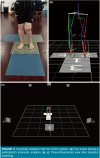Effect of posterior-stabilized and cruciate-retaining implants on three-dimensional kinematic characteristics after total knee arthroplasty
- PMID: 39719896
- PMCID: PMC11734864
- DOI: 10.52312/jdrs.2024.1836
Effect of posterior-stabilized and cruciate-retaining implants on three-dimensional kinematic characteristics after total knee arthroplasty
Abstract
Objectives: This study aimed to analyze the effects of posteriorstabilized (PS) and cruciate-retaining (CR) total knee arthroplasty (TKA) on early postoperative three-dimensional (3D) dynamic and kinematic characteristics in patients with unilateral knee osteoarthritis (OA).
Patients and methods: A retrospective analysis of prospectively collected data from 90 patients with unilateral TKA between February 2021 and September 2021 was conducted using a 3D kinematic analysis system before and six months after TKA. This patient group included 57 patients (10 males, 47 females; mean age: 69.5±7.5 years; range, 53 to 85 years) who underwent PS TKA and 33 patients (11 males, 22 females; mean age: 67.9±8.8 years; range, 45 to 86 years) who underwent CR TKA. The kinematic characteristics and clinical results of the two groups were compared. Clinical evaluation included the Hospital for Special Surgery knee score and range of motion (ROM). Twenty-eight healthy controls (9 males, 19 females; mean age: 64.5±2.9 years; range, 61 to 75 years) without knee OA matched for age, weight, height, and body mass index were recruited. The kinematic characteristics of the healthy control group were also evaluated.
Results: The PS group exhibited significant changes in basic gait parameters after TKA, including cadence (p=0.046), stride time (p=0.011), opposite foot off (p<0.001), opposite foot contact (p=0.038), step time (p=0.005), double support period (p<0.001), and foot off (p=0.004). No significant differences were observed in the kinematic parameters before and after TKA between the PS and CR groups, such as knee angle, moment, and force. The dynamic ROM of the CR group was greater than that of the PS group (p<0.001). Both the PS and CR groups showed significant deficiencies in flexion and extension function, including knee flexion moment, extension force, maximum flexion angle, and dynamic ROM, compared to healthy individuals. Throughout the gait cycle, both the PS and CR groups showed better knee joint stability compared to healthy individuals.
Conclusion: At six months postoperatively, both the PS and CR groups' gait patterns did not recover to a healthy state, and the CR group's gait pattern was more similar to OA. Compared to PS TKA, CR TKA allowed for greater dynamic ROM during gait. Despite exhibiting superior knee stability during gait, both implants' knee kinematics function remained inferior compared to healthy individuals.
Conflict of interest statement
Figures



Similar articles
-
Preoperative varus-valgus kinematic pattern throughout flexion persists more strongly after cruciate-retaining than after posterior-stabilized total knee arthroplasty.Knee. 2016 Aug;23(4):637-41. doi: 10.1016/j.knee.2015.11.015. Epub 2016 Apr 11. Knee. 2016. PMID: 27080743
-
Posterior Cruciate Ligament Retention versus Posterior Stabilization for Total Knee Arthroplasty: A Meta-Analysis.PLoS One. 2016 Jan 29;11(1):e0147865. doi: 10.1371/journal.pone.0147865. eCollection 2016. PLoS One. 2016. PMID: 26824368 Free PMC article.
-
Comparison of Contact Kinematics in Posterior-Stabilized and Cruciate-Retaining Total Knee Arthroplasty at Long-Term Follow-Up.J Arthroplasty. 2020 Jan;35(1):272-277. doi: 10.1016/j.arth.2019.07.046. Epub 2019 Aug 6. J Arthroplasty. 2020. PMID: 31473060
-
Comparison of posterior cruciate retention and substitution in total knee arthroplasty during gait: a systematic review and meta-analysis.J Orthop Surg Res. 2022 Mar 9;17(1):152. doi: 10.1186/s13018-022-03047-y. J Orthop Surg Res. 2022. PMID: 35264236 Free PMC article.
-
Smart Knee Implants and Functional Outcome for Total Knee Arthroplasty.J Knee Surg. 2025 Jul;38(8):397-402. doi: 10.1055/a-2550-2187. Epub 2025 Mar 4. J Knee Surg. 2025. PMID: 40037527 Review.
References
MeSH terms
LinkOut - more resources
Full Text Sources
Medical

